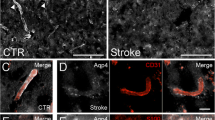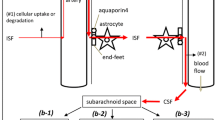Summary
We investigated the temporal profile of the extravasation of serum albumin in a reproducible gerbil model of unilateral cerebral ischemia, using immunohistochemical and dye-tracer techniques to evaluate albumin accumulation and the occurrence of active extravasation, respectively. After 30 min of cerebral ischemia and subsequent reperfusion, immunostaining for albumin became visible in the lateral part of the thalamus during the first 3 h, and then expanded to other brain regions up to 24 h. At both 24 h and 3 days after reperfusion, massive extravasation of albumin was noted in the whole ischemic hemisphere, and this had decreased again by 7 days after reperfusion. The extent and the degree of albumin immunopositivity were almost the same in all animals examined at each period after reperfusion. The extravasation of Evans blue, which was allowed to circulate for 30 min before death, was limited to the lateral part of the thalamus during the first 6 h of reperfusion. In the circumscribed area of massive albumin extravasation, many neurons were immunopositive for albumin; most of these neurons appeared to be intact and also showed immunostaining for microtubule-associated protein 2. The current investigation clearly demonstrated that (1) albumin extravasation was produced with reliable reproducibility in this model, (2) the lateral part of the thalamus was the region most vulnerable to ischemic blood-brain barrier damage, and (3) many apparently intact neurons in the ischemic region were positive for albumin.
Similar content being viewed by others
References
Bodsch W, Hossmann KA (1983) 125I-antibody autoradiography and peptide fragments of albumin in cerebral edema. J Neurochem 41:239–243
Bodsch W, Hurter T, Hossmann KA (1982) Immunochemical method for quantitative evaluation of vasogenic brain edema following cold injury of the rat brain. Brain Res 249:111–121
Bothe HW, Bodsch W, Hossmann KA (1984) Relationship between specific gravity, water content, and serum protein extravasation in various types of vasogenic brain edema. Acta Neuropathol (Berl) 64:37–42
Chui E, Wilmes F, Sotelo JE, Horie R, Fujiwara K, Suzuki R, Klatzo I (1981) Immunocytochemical studies on extravasation of serum proteins in cerebrovascular disorders. In: Cervos-Navarro J, Fritschka E (eds) Cerebral microcirculation and metabolism. Raven Press, New York, pp 121–127
Fishman RA (1986) Brain edema. In: Barnett HJM, Mohr JP, Stein BM, Yatsu FM (eds) Stroke, Churchill Livingstone, New York Edinburgh London Melbourne, pp 119–126
Ito U, Go KG, Walker JT, Spatz JM, Klatzo I (1976) Experimental cerebral ischemia in mongolian gerbils. III. Behavior of the blood-brain barrier. Acta Neuropathol (Berl) 34:1–6
Ito U, Ohno K, Nakamura R, Suganuma F, Inaba Y (1979) Brain edema during ischemia and after restoration of blood flow. Measurement of water sodium, potassium content and plasma protein permeability. Stroke 10:542–547
Kitagawa K, Matsumoto M, Niinobe M, Mikoshiba K, Hata R, Ueda H, Handa N, Fukunaga R, Isaka Y, Kimura K, Kamada T (1989) Microtubule-associated protein 2 as a sensitive marker for cerebral ischemic damage—Immunohistochemical investigation of dendritic damage. Neuroscience 31:401–411
Kitagawa K, Matsumoto M, Handa N, Fukunaga R, Ueda H, Isaka Y, Kimura K, Kamada T (1989) Prediction of strokeprone gerbils and their cerebral circulation. Brain Res 479:263–269
Klatzo I (1987) Pathophysiological aspects of brain edema. Acta Neuropathol (Berl) 72:236–239
Klatzo I, Chui E, Fujiwara K, Spatz M (1980) Resolution of vasogenic brain edema. Adv Neurol 28:359–373
Kuroiwa T, Cahn R, Juhler M, Goping G, Campbell G, Klatzo I (1985) Role of extravasated proteins in the dynamics of vasogenic brain edema. Acta Neuropathol (Berl) 66:3–11
Matsumoto M, Yamamoto K, Homburger HA, Yanagihara T (1987) Early detection of cerebral ischemic damage and repair process in the gerbil by use of an immunohistochemical technique. Mayo Clin Proc 62:460–472
Matsumoto M, Hatakeyama T, Akai F, Brengman JM, Yanagihara T (1988) Prediction of stroke before and after unilateral occlusion of the common carotid artery in gerbils. Stroke 19:490–497
Niinobe M, Maeda N, Ino H, Mikoshiba K (1988) Characterization of microtubule-associated protein 2 from mouse brain and its localization in the cerebellar cortex. J Neurochem 51:1132–1139
Ohtomo H, Hatakeyama T, Matsumoto M, Yanagihara T (1987) Postischemic damage in the gerbil brain after brief carotid occlusion: correlation of cerebral blood flow and immunohistochemical findings. J Cereb Blood Flow Metab 7 [Suppl 1]:S110
Salahuddin TS, Kalimo H, Johansson BB, Olsson Y (1988) Observations on exudation of fibronectin, fibronogen and albumin in the brain after carotid infusion of hyperosmolar solutions. An immunohistochemical study in the rat indicating longlasting changes in the brain microenvironment and multifocal nerve cell injuries. Acta Neuropathol 76:1–10
Sokrab TEO, Johansson BB, Kalimo H, Olsson Y (1988) A transient hypertensive opening of the blood-brain barrier can lead to brain damage—Extravasation of serum proteins and cellular changes in rats subjected to aortic compression. Acta Neuropathol (Berl) 75:557–565
Sokrab TEO, Johansson BB, Tengvar C, Kalimo H, Olsson Y (1988) Adrenaline-induced hypertension: morphological consequences of the blood-brain disturbance. Acta Neurol Scand 77:387–396
Suzuki R, Yamaguchi T, Kirino T, Klatzo I (1983) The effects of 5-minute ischemia in Mongolian gerbils. 1. Blood-brain barrier, cerebral blood flow, and local cerebral glucose utilization changes. Acta Neuropathol (Berl) 60:207–216
Uyama O, Okamura N, Yanase M, Narita M, Kawabata K, Sugita M (1988) Quantitative evaluation of vascular permeability in the gerbil brain after transient ischemia using Evans blue fluorescence. J Cereb Blood Flow Metab 8: 282–284
Wolman M, Klatzo I, Chui E, Wilmes F, Nishimoto K, Fujiwara K, Spatz M (1981) Evaluation of the dye-protein tracers in pathophysiology of the blood-brain barrier. Acta Neuropathol (Berl) 54:55–61
Yanagihara T (1978) Experimental stroke in gerbils: correlation of clinical, pathological and electroencephalographic findings and protein synthesis. Stroke 9:155–159
Author information
Authors and Affiliations
Additional information
Supported in part by a Grant-in-aid (01570485) from the Ministry of Education, Science and Culture and by a research grant for cardiovascular diseases (2A-2) from the Ministry of Health and Welfarc in Japan
Rights and permissions
About this article
Cite this article
Kitagawa, K., Matsumoto, M., Tagaya, M. et al. Temporal profile of serum albumin extravasation following cerebral ischemia in a newly established reproducible gerbil model for vasogenic brain edema: a combined immunohistochemical and dye tracer analysis. Acta Neuropathol 82, 164–171 (1991). https://doi.org/10.1007/BF00294441
Received:
Revised:
Accepted:
Issue Date:
DOI: https://doi.org/10.1007/BF00294441




